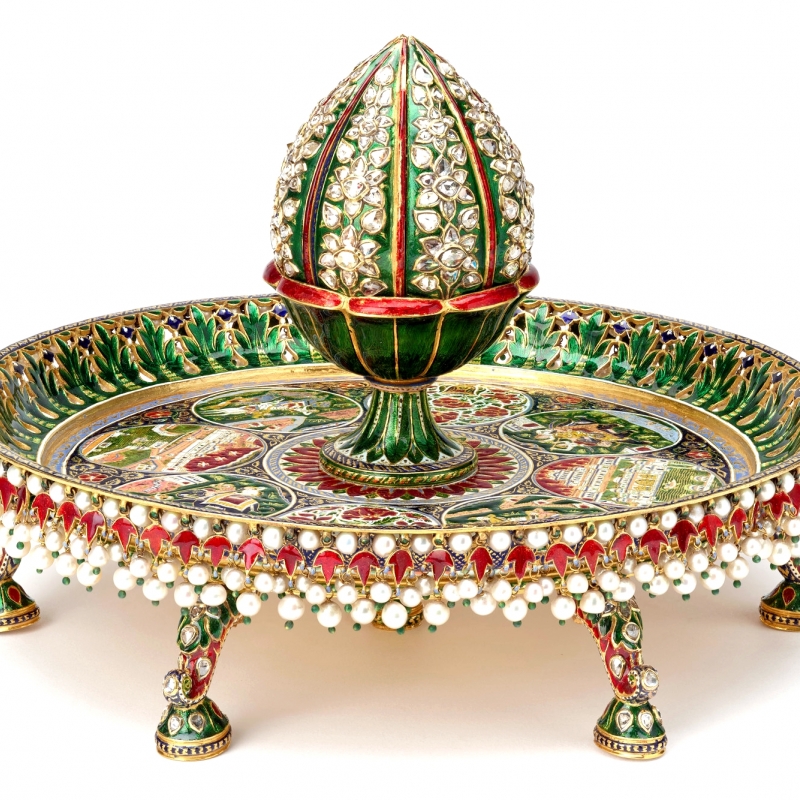Gift-giving has always played an importance role in cementing relationships. Here, we look at relationships of the political kind. The extravagant presentation by Maharaja Sawai Ram Singh II of Jaipur to the visiting Prince of Wales in February 1876 was as much a portrayal of Dhundaar as an artistic and prosperous kingdom, as it was to present the maharaja as an equal to England in influence and accomplishments. (Photo courtesy: Royal Collection Trust / © Her Majesty Queen Elizabeth II 2021)
While gifts have always been diplomatic devices (yes, even in relationships. We dare you to disagree). Be it ways to attract attention, rouse curiosity, and secure favours, gifts are also tokens of devotion, appreciation of service, and even an invitation to form alliances and a means of coercion.
But what was significant about the gifts offered by the Maharaja of Jaipur, Sawai Ram Singh II, to the Prince of Wales in February 1876 was that the items were carefully selected to not only portray the princely state of Dhundaar as an artistic and prosperous kingdom, but also as an equal to England in its influence and accomplishments. In the nineteenth century, as great exhibitions from colonies became popular, the nature of gifts and gift-giving changed from being publicly given (in a durbar, for example) and privately enjoyed to being privately offered (in a private audience) and publicly displayed. One of the most famous examples of this is the ivory throne of Travancore, which was sent to England as part of the Great Exhibition of 1851 by Raja Marthanda Varma ‘to curry favour with the British sovereign’, as Manu S. Pillai, author of The Ivory Throne, wrote in a column.[1]
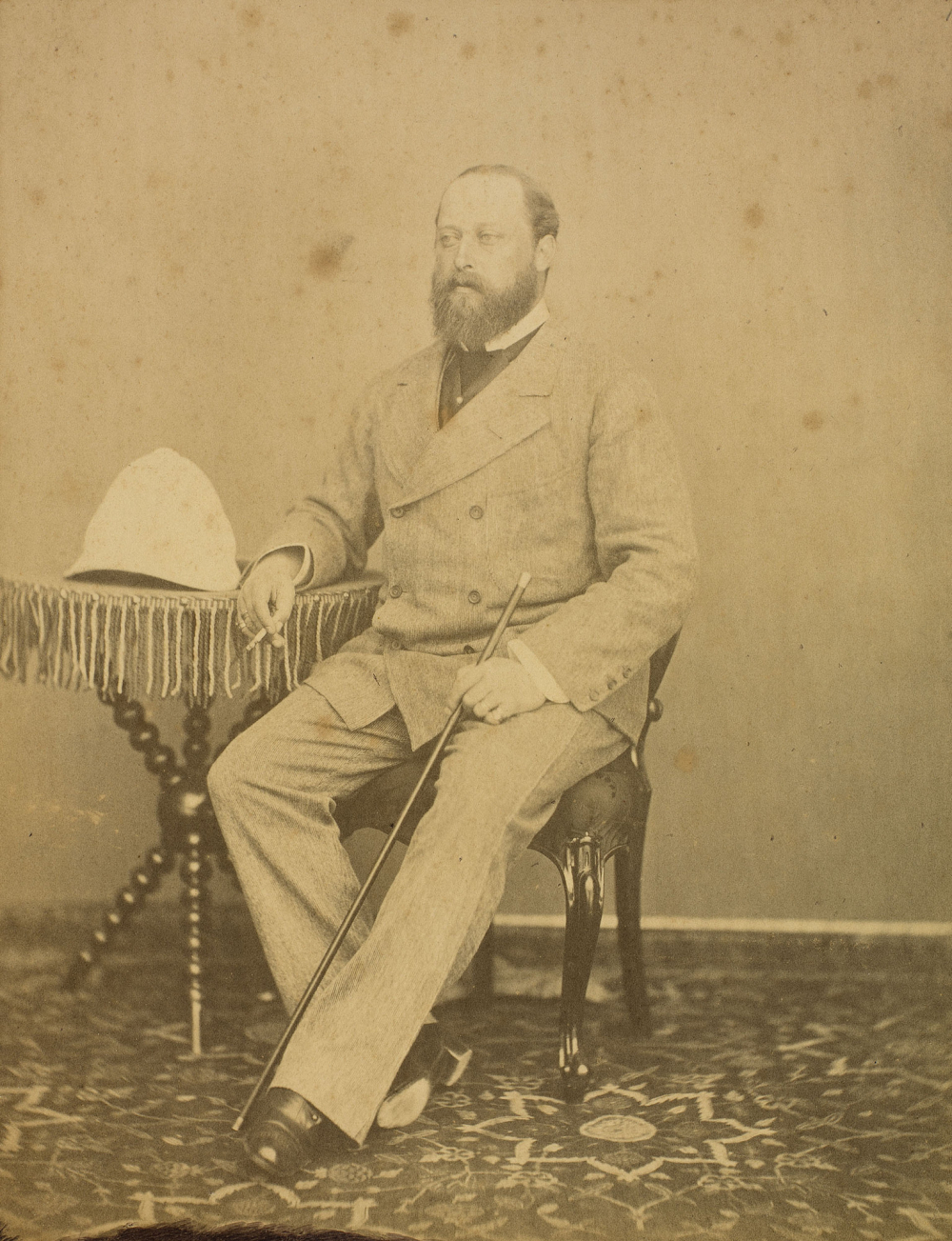
Promoting Art and Culture
At the time, Dhundaar (with Jaipur as its capital) was marked by instability. Amid struggles of regency rule, and attempts to influence by courtiers and British political agents, a sensitive, artistic and progressive maharaja took charge. After ascending the throne in 1851, Sawai Ram Singh II escalated reforms—paying special attention to education, modelled on ‘modern’ lines. Attention was paid to infrastructure and great public gardens, musicians were added to the performance atelier, a state-of-the-art theatre was built, and a photography studio was set up in the palace. The maharaja also established the Madarassa-e-Hunari, an arts and craft centre in 1857, which later thrived as the School of Art. The school had a wide curriculum, which merged traditional and European pedagogies. Integrating into the social, cultural and artistic fabric of the city, the objects created at the school were a part of the gifts received by the Prince of Wales.
Related article | Art N Soul: A Prince’s Tour of India
Sawai Ram Singh was also a keen photographer, a collector of images and made several portraits of himself, courtiers, women in his zenana, and visitors. Among his most well-known sitters was the Prince of Wales, Albert Edward, who stopped by Jaipur on his grand tour of the empire.
In 1876, colonisation was firmly embedded in India, so a visit by the heir apparent, Prince Albert Edward easily created much pomp and show among princely states. William Howard Russell, secretary to the Prince, was tasked with keeping a detailed diary of the voyage. The party made their way to Jaipur—the Pink City, where they were charmed by architecture, and Russell called its buildings ‘solid strawberry creams streaked in white arabesque’. This fascination for what he calls ‘street architecture’ is not misplaced; like Haussmann’s Paris,[2] Jaipur’s avenues and facades were well planned, and being a prosperous mercantile capital, houses were rather splendidly built—both inside and outside! Of the many gifts that Sawai Ram Singh gave the Prince of Wales, perhaps the most charming was a model of a Jaipur haveli. All the elements of traditional haveli—like a central courtyard open to the skies, with rooms on all sides, terraces, windows and balconies—were skillfully depicted. Attention was paid to tile work and the lowest register was decorated with murals of a procession leading up to the entrance.
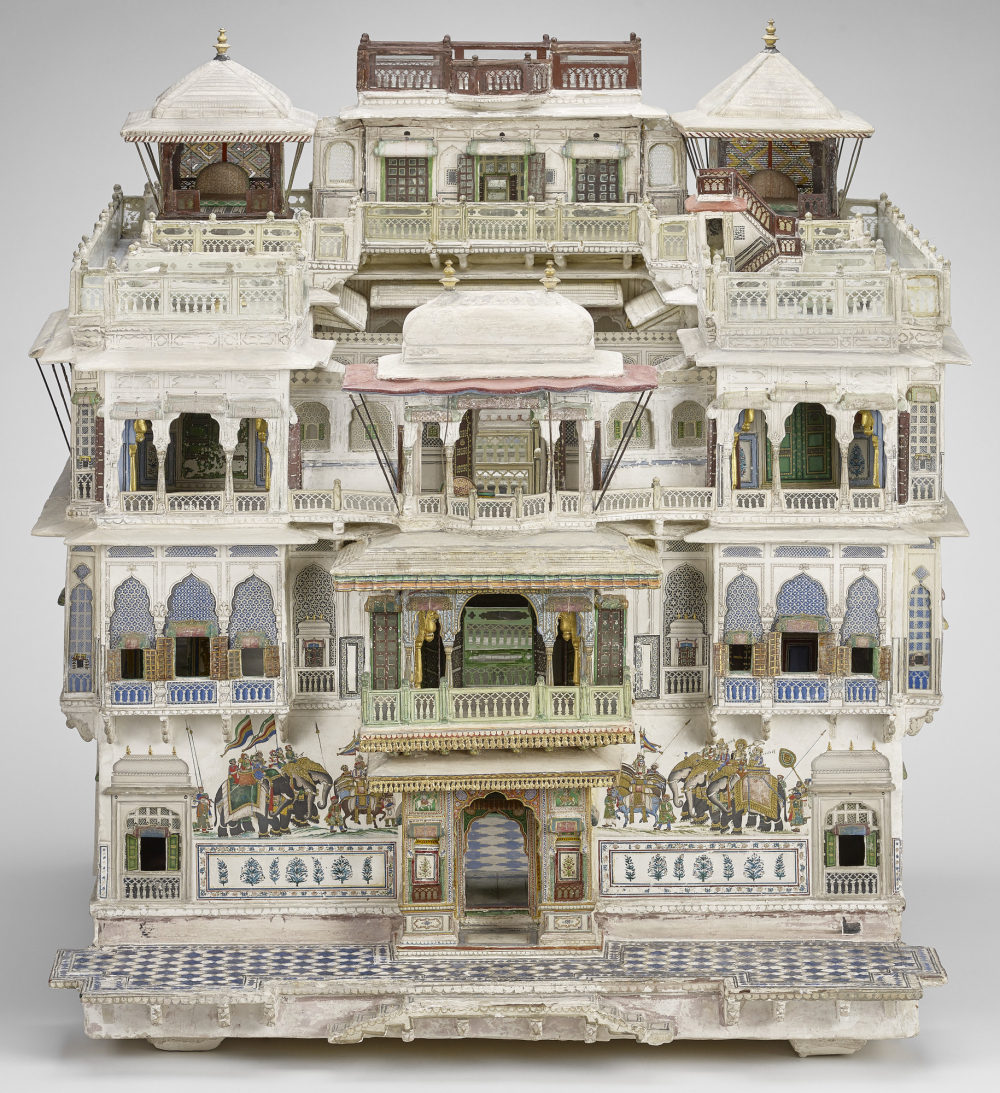
The Perfect Haveli
Havelis in Rajasthan absorb Mughal and Indic architectural styles, with European influences from the nineteenth and twentieth centuries. This model, made in plaster by the students of the School of Art, was not a miniature version of an actual haveli or a model to have one built, but an imagined perfect house with carefully chosen architectural elements from Jaipur’s rather large repertoire. For instance, the windows mimic the Chandra Mahal facade, which was one of Jaipur’s earliest buildings and one of its most iconic too, since it was the maharaja’s residence. The model Jaipur haveli, then, as an amalgamation of idealised architecture and a real building of significance, was a way to draw connections to the legendary architecture of Jaipur as well as to showcase the talent and skill of the School of Art founded by the maharaja. As a photographer, he understood and played with objects and props quite effectively. He knew the impact a large model like this would have when displayed, and anticipated its unique and visible position among other fine objects.
Power Symbols
Sawai Ram Singh highlighted his historical lineage with an astrolabe that commemorated Sawai Jai Singh II, a celebrated astronomer and mathematician, and Jaipur’s founder. To showcase the finesse and high-quality craftsmanship of contemporary Jaipur, he commissioned master craftsman to make several objects such as a teacup, which was European in form but had Jaipur’s famous enamel work. Traditional objects like an enameled salver featured both the Chandra Mahal and Jal Mahal. Once again, architecture was used to reiterate Jaipur’s exalted status and legacy. Similarly, the plate at the bottom of a perfume holder had medallions depicting the palace of Amber and Chandra Mahal—the old and the new capital.
Also read | Ritual Singing Tradition in Rajasthan: Navigating the Gendered Space of Religion
The maharaja’s repeated use of the Chandra Mahal and Amber iconography was deliberate as symbols of his glorious lineage. These, and other gifts he gave, are in the Royal Collection Trust, and a selection were put together in the Splendours of the Subcontinent exhibition in 2017–18.[3]
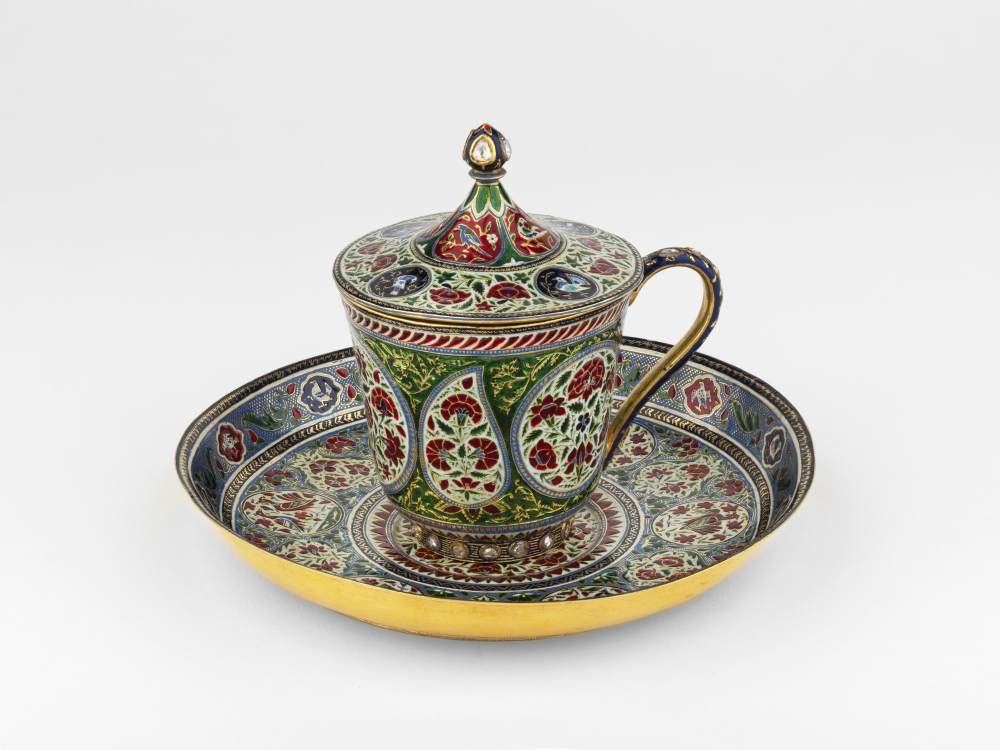
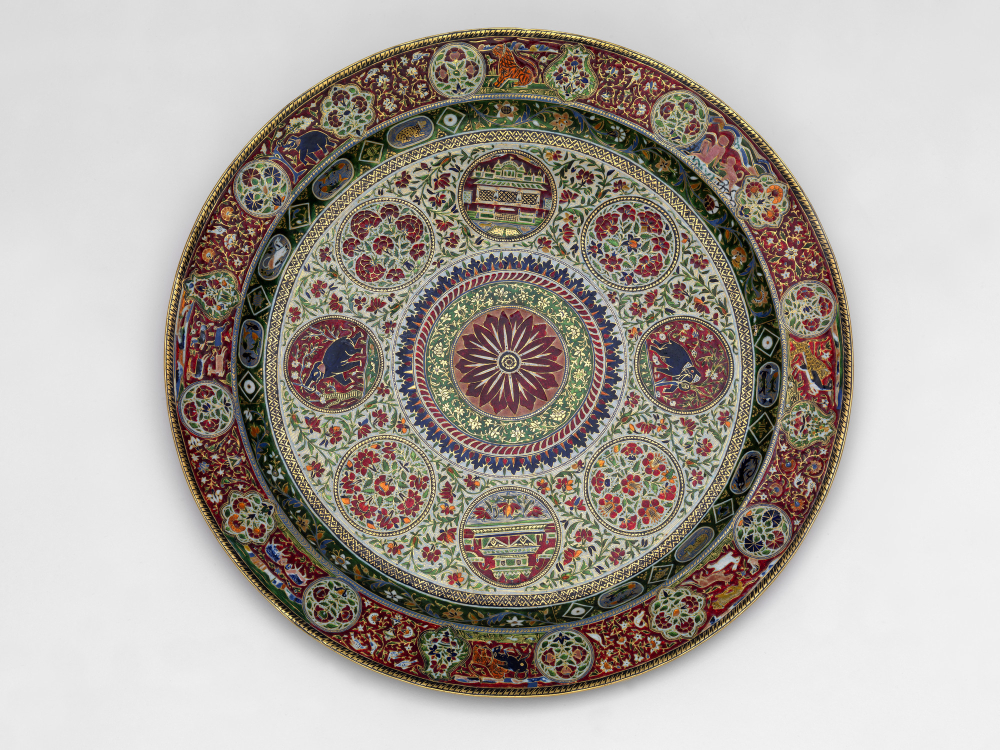
Rooting for Local
Sawai Ram Singh II made sure the gifts given to the future king of England were a combination of heirloom (which connected Amber and Jaipur to the English crown), and new objects from the School of Art or one of the karkhanas (workshops) of Jaipur. New objects would be displayed in England and Europe, encouraging local production of art and craft, which still persists. These gifts also created opportunities for interventions and experimentation, leading to signature production like Jaipur’s famous blue pottery.
Gift-giving cemented relationships significantly—but very differently—through the eighteenth and nineteenth centuries. In the former, new kings used presents to articulate their unique identity and kingship, which in turn fostered a new era of artistic practices. By the nineteenth century, negotiating with the European colonisers required a new approach, one that would highlight the lineage of Indian rulers and posit them as equals to the English crown, attempting to keep their Indian and local identity intact. Gift-giving practices had to be imperial and local at once, in form and meaning, and through the display and travel of gift objects, a vision of India was brought to world.
This content has been created as part of a project partnered with Royal Rajasthan Foundation, the social impact arm of Rajasthan Royals, to document the cultural heritage of the state of Rajasthan.
The article was also published on Scroll.in.
Notes
[1] Pillai, Manu S., ‘Much Ado about a Royal Throne,’ Livemint, New Delhi, March 15, 2019. Accessed February 1, 2021. https://www.livemint.com/mint-lounge/features/opinion-much-ado-about-a-royal-throne-1552619149456.html.
[2] Georges-Eugene Haussmann’s renovation of Paris was a vast public works programme commissioned by Emperor Napoleon III between 1853 and 1870.
[3] The 2017–18 Splendours of the Subcontinent exhibition was curated by Kajal Meghani. The catalogue is a valuable source of information, along with interactive maps and material on the RCT website.
